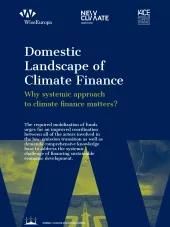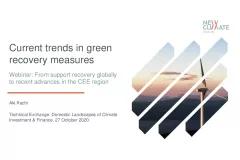In the coming years, Poland will gain access to unprecedented funds for thermal modernization of buildings. Limited monitoring of financial flows in the area of building renovation creates a risk of only partial and inefficient use of this opportunity.
Main Findings:
Thermal modernisation of buildings does not only play a key role in reducing greenhouse gas emissions but can also be an important stimulus measure for the recovery of European economies after the crisis caused by the COVID-19 pandemic. It is one of the key investment areas supported not only by the EU’s Multiannual Financial Framework for 2021-2027, but also by the Recovery and Resilience Facility. The European strategy for the buildings sector, the “Renovation Wave”, presents both legislative solutions and proposals for specific financial facilities to address both the challenges. We are therefore at a historic moment when unprecedented funds from the European Union can flow towards the thermal modernisation of buildings. Nevertheless, fragmented information on the scale, sources and instruments of financing, as well as the degree of involvement of different groups of investors in the renovation of buildings, hinder implementation of public policy in this area, and also carry the risk of incomplete or ineffective use of European funding offered under the EU Recovery plan. Making use of these funds will require a precise definition of the domestic investment needs and associated financial instruments. Based on a climate finance landscaping exercise for the Polish buildings sector assessing total investments in low-carbon energy sources and energy efficiency in four building types and the relationship between private and public funding we make the following recommendations:
- Tie the support to the increase in efficiency achieved. Making the level of support dependent on the depth of the thermal modernisation and the expected environmental effects of low-carbon energy sources in buildings, is likely to have a positive impact not only on the ambition of renovations and thus the reduction of the sector’s emissions, but also on the improvement of the efficiency of spending of public funds.
- Design long-term support programmes with continuous calls for applications. Stable conditions and clear rules for the provision of financing may contribute to the increase of the confidence of all groups of investors and, consequently, the increase of the quality of the projects carried out.
- Organise support systems in a way that ensures that overlaps and competition between the support programmes are avoided. It is recommended to standardise the conditions of support, the requirements for environmental impact and the types of eligible costs at the level of individual types of buildings.
- Standardise programmes evaluation along with the monitoring of investment projects and financial flows, as well as the collection of and sharing with data. The creation of a coherent reporting system and consistent collection of data related to the implemented projects could contribute to effective monitoring of the progress and the information flow between the entities interested in low-carbon investments in buildings. In addition, the restrictions related to European funds, which Poland will have at its disposal in the next decade, will translate into the necessity to implement a methodology for tracking financial flows towards low-carbon investments in order to demonstrate the share of green investments in the structure of spending of European funding.




